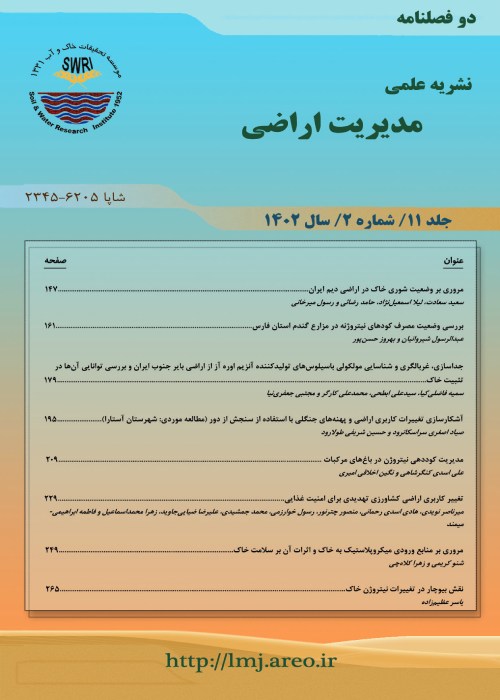Study of soil fertility of wheat farms in Qazvin PlainSome extension guidelines
Enhancements in crop yield and quality depend on proper use of chemical fertilizers, the most important tool for which is a comprehensive understanding and accurate knowledge of the fertility status of the soil under cultivation. The present study presents a review of the fertility of soils under wheat cultivation in Qazvin Plain in an attempt to formulate extension guidelines for facing the challenges due to soil limitations hindering satisfactory wheat yield. For this purpose, use was made of 43120 soil analytical data obtained from 2695 samples collected from Qazvin Plain to study the 12 soil physicochemical properties of soil texture, pH, and EC as well as lime, organic carbon, phosphorus, potassium, iron, copper, manganese, and boron contents. The results showed that, while a major portion of the soils studied was loam, more than 78% were alkaline in nature with pH values of 7 to 8. Also, the soils were found to suffer from such limitations as deficient available K, manganese, copper, and boron. Given an electrical conductivity of less than 2 dS m-1 obtained for the soil saturation extract, 47.1% of the soils in the plain were identified as non-saline. Calcium carbonate accounted for more than 96% of the soils as affected by lime. Moreover, the soils were drastically deficient in organic content as revealed by the organic carbon index that indicated an organic carbon content of less than 1% in 93.5% of the soils examined. Critical phosphorus and potassium levels were measured at 15 and 300 mg kg-1, respectively, indicating 27% of the soils in need of phosphorus fertilizer application but more than 80% in no need of potassium fertilizers. The critical levels of iron, zinc, manganese, boron, and copper were measured at 5, 1, 5, 1, and 1mg kg-1, respectively, such that about 74% of the studied areas suffered from iron deficiency, 64% from zinc deficiency, 17% from manganese deficiency, 27% from boron deficiency, and about 30% from copper deficiency. Thus, soil micronutrients were not uniformly distributed across the wheat farms. It is, therefore, essential to formulate recommendations duly based on plant needs and to avoid uniform application of the same fertilizers on all soils with different deficiencies in order to achieve desirable yields at lower production costs.
- حق عضویت دریافتی صرف حمایت از نشریات عضو و نگهداری، تکمیل و توسعه مگیران میشود.
- پرداخت حق اشتراک و دانلود مقالات اجازه بازنشر آن در سایر رسانههای چاپی و دیجیتال را به کاربر نمیدهد.


